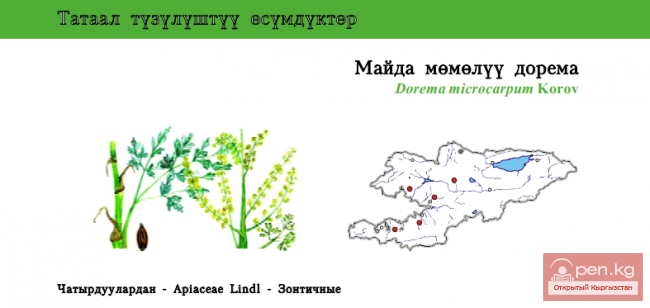
Rhodiola litwinowii Status: LC. A mosaic-distributed species, intensively used in agriculture....

Kostychev’s Pascueflower Status: VU. A narrowly endemic and very beautiful plant, deserving...

Semenov’s Onion Status: VU. Endemic to the Inner Tien Shan....

Eugenia's Primrose Status: VU. A narrow endemic rare, highly ornamental species. Found in...

Aulie-Ata Stemmacantha Centaury Status: EN. A very rare species, critically endangered....

False Hooked Fumitory Status: VU. Endemic species of the Pamir-Alai....

html Korshinsky’s Meadow Saxifrage Status: EN. A rare endemic species found in small numbers and...

Catmint-like Scullcup Status: VU. A very rare narrowly endemic species. Ornamental plant....

Cnidiocarpa alaica Status: VU. A rare representative of a monotypic genus....

Hairy Flowering Plant Aulie-Ata Status: EN. A representative of a monotypic section, a narrowly...

Kaufmannia Semenova Status: VU. Endemic, rare species....

Iskandera Alai Status: VU. A very rare narrow endemic species. There is only one species of this...

Susamyr Catchfly Status: EN. A rare species found in small numbers and in a limited area, which...

Kosopoljanskaya Turkestanian Status: VU. One of the two endemic species of this genus found in...

Large-calyxed Primrose Status: VU. In Kyrgyzstan, it is a very narrowly distributed, rare,...

Alai Bubblewort Status: VU. A rare narrowly endemic species....

Wolly-fruited Kosopoljanskia Status: EN. Endemic. One of the two species that are sub-endemic to...

Anomalous Alajja (Erianthera anomala) Status: VU. Endemic to the mountains of Central Asia. A rare...

Edelweiss-like Pyrethrum Status: VU. Endemic species....

html Lamyropappus schakaptaricus Status: VU. A rare representative of a monotypic genus....

Seaholly-like Meadow Saxifrage Status: VU. Endemic. One of 16 species found in Kyrgyzstan....

Tianschaniella umbellifera Status: VU. A significantly declining narrowly endemic species of...

Alai Centaury Status: VU. Endemic species....

Obtusilobous Windflower Status: VU. The westernmost boundary of its range in Kyrgyzstan is located...

Golden Trichanthemis Centaury Status: VU. A rare narrowly endemic species of the Alai Ridge, an...

Orchid-like Juno Status: VU. Endemic to the Western and Northern Tien Shan....

Broad-stamened Tulip Status: VU. A narrow endemic of the Alai Ridge....

Pskem Onion Status: EN. A very rare species with a shrinking range in the Western Tien Shan....

Regel’s Eminium Status: VU. A rare endemic species of the Western Tien Shan....

Twelve-dentate Onion Status: VU. A narrowly endemic species of the Chatkal Ridge. Description. A...

Wrapped Alpine Saw-wort Status: VU. Rare species. Found in Kyrgyzstan at the edge of its range....

Kashgarian Barberry Status: VU. Rare species....

Dorema microcarpum Status: VU. Rare endemic species....

Schrenk’s False Spirea Status: CR B2ab(iii). Endemic, ornamental, and rare plant with a decreasing...

Chesneya villosa Status: EN. One of the three very rarely encountered species of this genus in...

Vvedensky’s Sage Status: VU. A very rare narrowly endemic species. An ornamental plant....

Iridodictyum Kolpakovski Status: VU. A species with a reducing range and population. It deserves...

Andrachne-like Scullcup Status: VU. A very rare rocky species, narrowly endemic to a small section...

Intermediate Hyalolaena Status: VU. Endemic. One of three species growing in Kyrgyzstan....

Eremurus Zenaidae Status: VU. Endemic to the lower and middle belts of the Fergana and Alai...

Chaeto-fruited Sweet Broom Status: EN. A relic endemic species found in walnut-fruit forests....

Tien Shan Sibiraea Status: CR. An endemic, decorative, and rare northern Tien Shan plant....

A specific form of natural conditions is represented by the internal adverse dangerous natural...